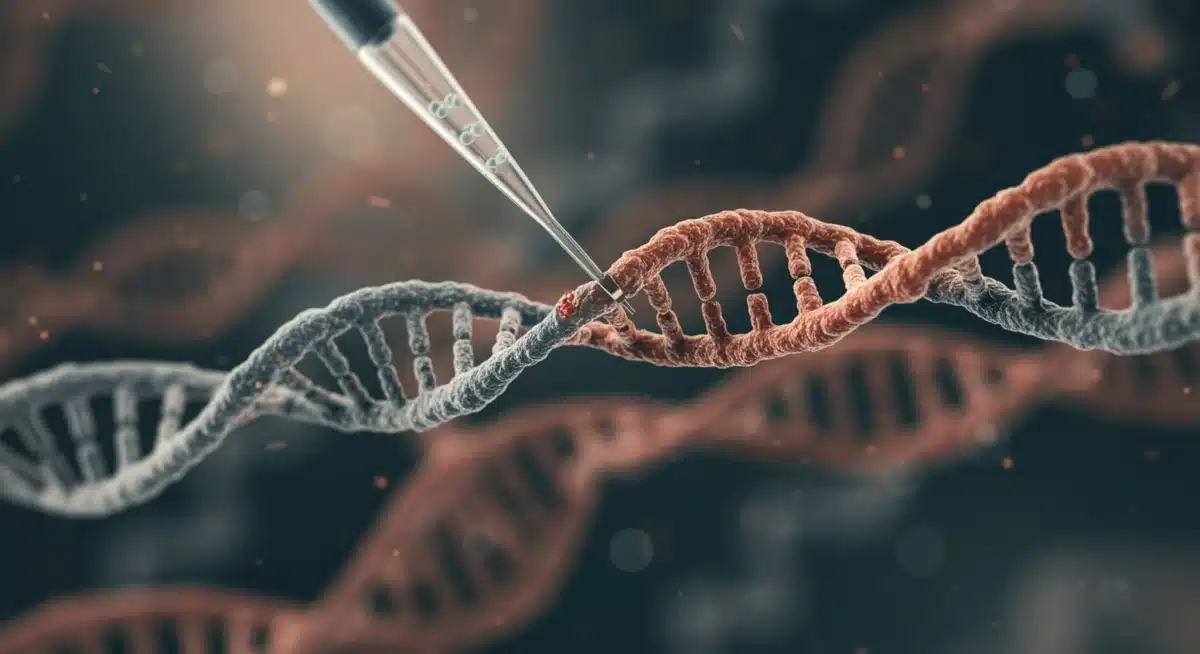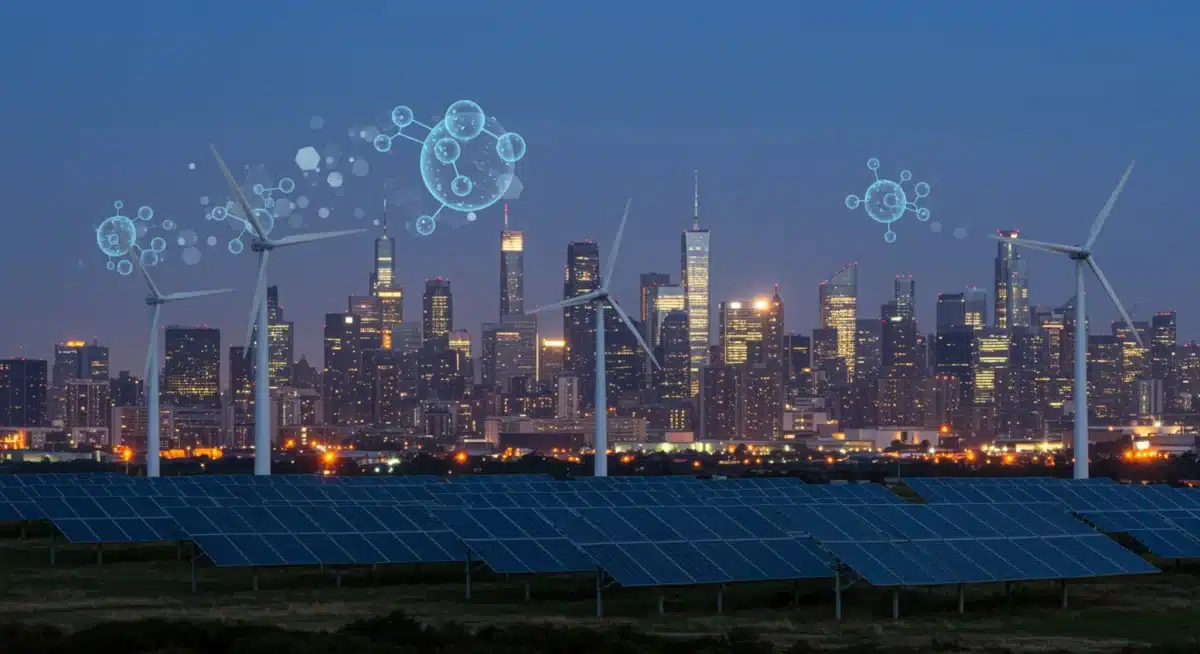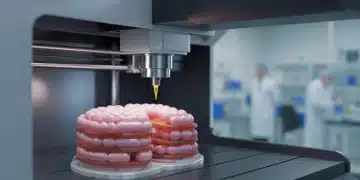Synthetic Biology: US Innovation’s Rise & Challenges

Synthetic biology is profoundly impacting US innovation by creating unprecedented opportunities across healthcare, energy, and agriculture, while also necessitating careful navigation of significant ethical, regulatory, and economic challenges to ensure responsible and sustainable growth.
The landscape of scientific discovery is currently undergoing a radical transformation, driven by an emergent field that promises to redefine our understanding of life itself. The Rise of Synthetic Biology: Opportunities and Challenges for US Innovation is not merely a scientific pursuit; it’s a strategic imperative that holds the key to unlocking solutions for some of humanity’s most pressing issues, from disease eradication to sustainable energy. This fascinating domain, at the intersection of biology, engineering, and computer science, is rapidly evolving, positioning the United States at the forefront of a biological revolution. But what exactly is synthetic biology, and how is it poised to reshape the future of American ingenuity and economic prowess?
Understanding the Foundations of Synthetic Biology
Synthetic biology, often described as engineering biology, involves the design and construction of new biological parts, devices, and systems, or the redesign of existing natural biological systems for useful purposes. Unlike traditional genetic engineering, which primarily involves moving genes between organisms, synthetic biology aims to apply engineering principles to biology. This means standardizing biological components so they can be assembled and reassembled predictably, much like electronic circuits. It’s about building biological systems from the ground up, with a specific function in mind.
This approach allows scientists to create organisms with novel capabilities, such as bacteria that produce biofuels, yeast that synthesize pharmaceuticals, or plants that can detect pollutants. The field draws heavily on advancements in DNA sequencing and synthesis, computational modeling, and automation. The ability to read, write, and edit genetic code with increasing speed and affordability has fueled an explosion of possibilities, moving synthetic biology from theoretical concepts to tangible applications.
Key Principles Guiding Synthetic Biology
At its core, synthetic biology operates on several fundamental engineering principles. These principles are crucial for transforming biology from a descriptive science into a predictive and constructive one, enabling the precise manipulation of biological systems.
- Standardization: Creating interchangeable biological parts (BioBricks) that can be easily combined.
- Abstraction: Developing hierarchical levels of design, from individual genes to complex systems.
- Decoupling: Separating the design process from the fabrication process, similar to integrated circuit manufacturing.
- Modularity: Designing components that can function independently and integrate seamlessly.
These principles are not just academic; they are the bedrock upon which the entire edifice of synthetic biology is being built. They allow for systematic experimentation, rapid prototyping, and the eventual large-scale deployment of synthetic biological solutions. The capacity to reliably engineer biological functions opens up vast new avenues for innovation, making the US a critical player in this emerging domain.
In essence, synthetic biology is about intentional design and construction, giving us unprecedented control over biological functions. This foundational understanding is vital for appreciating the breadth of opportunities and the depth of challenges that lie ahead for US innovation in this dynamic field.
Opportunities in Healthcare and Medicine
The potential of synthetic biology to revolutionize healthcare and medicine is immense, offering new paradigms for disease diagnosis, treatment, and prevention. From personalized medicine to novel drug discovery, the applications are set to transform patient care and public health outcomes across the United States and globally. This field is moving beyond traditional pharmaceuticals, embracing living systems as therapeutic agents.
One of the most exciting areas is the development of engineered living therapeutics. This involves programming cells, often bacteria or human cells, to perform specific tasks within the body, such as detecting cancer cells and delivering targeted therapies, or producing essential compounds that the body lacks. Imagine bacteria engineered to colonize the gut and produce anti-inflammatory molecules for Crohn’s disease, or immune cells reprogrammed to aggressively seek and destroy tumors.
Advanced Diagnostics and Gene Therapies
Synthetic biology is also paving the way for advanced diagnostic tools that are more sensitive, specific, and rapid than current methods. Biosensors, engineered from biological components, can detect disease markers at very early stages, allowing for timely intervention. Furthermore, the field is significantly advancing gene therapy, moving beyond correcting single gene defects to engineering more complex genetic repairs and modifications. This includes:
- CRISPR-based therapies: Enhancing precision and efficiency in gene editing for inherited diseases.
- Engineered viruses: Designing viral vectors for safer and more effective gene delivery.
- Cellular reprogramming: Converting one cell type into another for regenerative medicine applications.
These innovations promise to tackle diseases that were once considered untreatable, offering hope to millions. The ability to precisely manipulate genetic material and cellular functions is fundamentally changing how we approach health and illness. The US, with its robust biotech ecosystem and significant investment in research, is uniquely positioned to lead these advancements.
The integration of synthetic biology into healthcare is not just about new technologies; it’s about a paradigm shift in how we conceive of medical interventions. By engineering biological systems with purpose, we are opening doors to treatments that are more effective, less invasive, and highly personalized, promising a healthier future for American citizens.

Environmental Sustainability and Bioenergy
Beyond healthcare, synthetic biology offers transformative solutions for environmental sustainability and the pressing global need for renewable energy. The ability to engineer biological systems can address challenges related to pollution, resource depletion, and climate change, positioning the US as a leader in green technology innovation. This field provides a biological toolkit for building a more sustainable future.
One primary focus is on developing advanced biofuels. Traditional biofuels often compete with food crops or have limited energy density. Synthetic biology aims to engineer microbes, such as algae or bacteria, to produce high-yield, sustainable fuels from non-food feedstocks or even directly from carbon dioxide. This could significantly reduce our reliance on fossil fuels and mitigate greenhouse gas emissions, contributing to energy independence.
Bioremediation and Biomanufacturing
Another crucial application lies in bioremediation, where engineered organisms can be deployed to clean up environmental pollutants. Microbes can be designed to break down plastics, neutralize toxic waste, or capture atmospheric carbon dioxide more efficiently than natural processes. This offers a powerful, biologically-driven approach to environmental clean-up and restoration.
- Plastic degradation: Engineering bacteria to consume and break down various types of plastics.
- Heavy metal detoxification: Developing microbes that can absorb or transform toxic heavy metals in soil and water.
- Carbon capture: Enhancing photosynthetic organisms to sequester more CO2 from the atmosphere.
Furthermore, synthetic biology is revolutionizing biomanufacturing. Instead of relying on traditional chemical processes that often generate harmful byproducts and consume vast amounts of energy, we can program microorganisms to produce a wide array of chemicals, materials, and even food ingredients. This includes everything from sustainable textiles and biodegradable plastics to flavor compounds and nutritional supplements, all with a significantly reduced environmental footprint.
The integration of synthetic biology into environmental and energy sectors is not just about incremental improvements; it represents a fundamental shift towards bio-based economies. By harnessing the power of engineered life, the US can develop innovative solutions that protect our planet, reduce waste, and create a sustainable energy future, fostering both ecological health and economic growth.
Advancements in Agriculture and Food Production
Synthetic biology is poised to revolutionize agriculture and food production, addressing critical global challenges such as food security, climate resilience, and sustainable resource management. For US innovation, this means developing crop varieties that are more nutritious, resistant to pests and diseases, and capable of thriving in diverse, often challenging, environmental conditions. The goal is to produce more food with less environmental impact.
One key area is the engineering of crops for enhanced nutritional content and improved yields. Scientists are using synthetic biology tools to introduce new metabolic pathways into plants, leading to crops with higher vitamin levels, better protein profiles, or increased resistance to drought and salinity. This not only boosts agricultural productivity but also contributes to global health by combating malnutrition.
Pest Resistance and Sustainable Fertilization
The development of pest and disease-resistant crops is another significant opportunity. By engineering plants to produce natural pesticides or to activate immune responses against common pathogens, synthetic biology can dramatically reduce the need for chemical sprays, which are often harmful to the environment and human health. This leads to more sustainable farming practices and safer food products.
- Disease-resistant strains: Engineering crops to withstand common fungal, bacterial, and viral infections.
- Bio-pesticide production: Incorporating genes for natural pest deterrents directly into plant genomes.
- Nitrogen fixation enhancement: Modifying crops or their associated microbes to fix atmospheric nitrogen, reducing reliance on synthetic fertilizers.
Moreover, synthetic biology can contribute to more sustainable fertilization practices. Many crops rely heavily on synthetic nitrogen fertilizers, which are energy-intensive to produce and contribute to water pollution. Researchers are exploring ways to engineer crops or symbiotic microbes to enhance natural nitrogen fixation, making agriculture less dependent on chemical inputs and more environmentally friendly. This approach promises to create a more resilient and sustainable agricultural system for the US and beyond.
The application of synthetic biology in agriculture is about building a more robust and sustainable food system. By designing crops and farming methods that are both productive and eco-conscious, the US can ensure food security for its population while also setting a global standard for responsible agricultural innovation.

Ethical and Societal Challenges
While the opportunities presented by synthetic biology are vast and exciting, the field also presents a complex array of ethical, social, and governance challenges that demand careful consideration. For US innovation to proceed responsibly, these concerns must be addressed proactively, ensuring public trust and mitigating potential risks. The power to redesign life comes with significant responsibilities.
One of the foremost ethical concerns revolves around the concept of ‘playing God’ and the potential for unintended consequences. The ability to create novel organisms or alter existing ones raises questions about our right to modify natural systems and the long-term ecological impacts of releasing engineered life forms into the environment. There is a need for robust risk assessment frameworks and continuous monitoring.
Biosecurity and Equitable Access
Biosecurity is another critical challenge. The same tools that allow for beneficial engineering could potentially be misused for harmful purposes, such as creating bioweapons or enhancing pathogens. Therefore, stringent regulations, international cooperation, and responsible research practices are essential to prevent malicious applications of synthetic biology. This requires a delicate balance between fostering innovation and ensuring global safety.
- Dual-use research: Managing the risks associated with technologies that have both beneficial and harmful potential.
- Access and equity: Ensuring that the benefits of synthetic biology are accessible to all, not just privileged populations.
- Public perception: Addressing public fears and misconceptions through transparent communication and education.
Furthermore, equitable access to the benefits of synthetic biology is a significant societal consideration. As these technologies advance, there is a risk that they could exacerbate existing health and economic disparities if innovations are not made affordable and accessible to all segments of society. Ensuring that the fruits of synthetic biology are shared broadly will be crucial for its long-term societal acceptance and impact.
Navigating these ethical and societal challenges requires ongoing dialogue among scientists, policymakers, ethicists, and the public. For US innovation in synthetic biology to truly flourish, it must be guided by a strong ethical compass and a commitment to responsible development, ensuring that the benefits outweigh the risks for all.
Regulatory Landscape and Public Policy
The rapid pace of synthetic biology innovation necessitates a dynamic and adaptive regulatory landscape to ensure safety, ethical conduct, and public acceptance. In the United States, navigating this complex terrain is crucial for fostering innovation while simultaneously protecting public health and the environment. The current regulatory framework, often based on existing biotechnology guidelines, is constantly being evaluated for its suitability to address novel synthetic biology products.
Currently, synthetic biology products are regulated by a patchwork of agencies, including the FDA (Food and Drug Administration), EPA (Environmental Protection Agency), and USDA (U.S. Department of Agriculture), depending on the application. This multi-agency approach can sometimes lead to ambiguities, overlapping jurisdictions, or gaps in oversight. A harmonized and clear regulatory pathway is vital for companies to bring their innovations to market efficiently and safely.
Challenges in Regulatory Adaptation
One of the main challenges is that synthetic biology products often blur the lines between traditional categories of drugs, chemicals, or agricultural products. For instance, an engineered microbe could be considered a living drug, a pesticide, or a food additive, depending on its intended use. This complexity requires regulators to adapt existing frameworks or develop new ones that are flexible enough to accommodate rapidly evolving technologies.
- Defining ‘novelty’: Establishing clear criteria for when a synthetic biology product requires new regulatory scrutiny.
- Risk assessment methodologies: Developing robust methods to assess the environmental and health risks of engineered organisms.
- International harmonization: Collaborating with global partners to create consistent regulatory standards.
Public policy also plays a critical role in shaping the trajectory of synthetic biology. Policies related to research funding, intellectual property, and public engagement can either accelerate or hinder innovation. The US government’s investment in foundational research and its commitment to developing clear guidelines will be instrumental in maintaining its leadership position in this field. Engaging the public through transparent communication about the benefits and risks is also essential for building trust and ensuring societal acceptance.
Ultimately, a balanced and forward-thinking regulatory and public policy approach is indispensable for the sustainable growth of synthetic biology in the US. By providing clarity, ensuring safety, and fostering public confidence, these frameworks will allow American innovation to reach its full potential in this transformative scientific domain.
The Future Outlook for US Synthetic Biology
The future of synthetic biology in the United States is bright, marked by continued rapid advancements, expanding applications, and a growing ecosystem of research, industry, and investment. As the field matures, its impact on various sectors is expected to become even more profound, solidifying the US’s position as a global leader in this biological revolution. The trajectory suggests an era of unprecedented bio-innovation.
One major trend is the increasing integration of artificial intelligence (AI) and machine learning (ML) with synthetic biology. AI can accelerate the design of biological systems, predict their behavior more accurately, and optimize experimental protocols, significantly reducing the time and cost of development. This synergy between digital and biological technologies will unlock capabilities currently unimaginable, driving efficiency and discovery at an exponential rate.
Economic Impact and Workforce Development
The economic impact of synthetic biology is projected to be substantial, creating new industries, jobs, and markets. The development of bio-based products and processes will reduce manufacturing costs, decrease reliance on finite resources, and open up new avenues for economic growth. This will necessitate a focus on workforce development, ensuring that the US has a skilled talent pool capable of driving and sustaining this innovation.
- Increased private investment: Growing venture capital and corporate funding for synthetic biology startups.
- New job creation: Demand for bioengineers, computational biologists, and biomanufacturing specialists.
- Global competitiveness: Strengthening the US’s position in advanced manufacturing and life sciences.
Furthermore, international collaboration will become increasingly important. While the US aims to lead, global challenges like pandemics, climate change, and food security require a concerted international effort. Sharing knowledge, resources, and best practices will accelerate progress and ensure that the benefits of synthetic biology are realized worldwide. This collaborative spirit, combined with robust domestic innovation, will define the next chapter of synthetic biology.
In conclusion, the future of synthetic biology in the US is one of immense promise and ongoing evolution. By leveraging technological convergence, nurturing a skilled workforce, and engaging in responsible global partnerships, the United States is poised to harness the full potential of this transformative field, addressing critical challenges and shaping a healthier, more sustainable, and prosperous future for all.
| Key Aspect | Brief Description |
|---|---|
| Healthcare Advances | Revolutionizing diagnostics, targeted therapies, and regenerative medicine with engineered cells. |
| Environmental Solutions | Developing sustainable biofuels, bioremediation for pollution, and eco-friendly biomanufacturing. |
| Agricultural Improvement | Creating resilient, nutritious crops and reducing reliance on chemical pesticides and fertilizers. |
| Ethical & Regulatory Hurdles | Addressing biosecurity risks, equitable access, and evolving regulatory frameworks for safe innovation. |
Frequently Asked Questions About Synthetic Biology
Synthetic biology involves designing and constructing new biological parts or systems, or redesigning existing ones, using engineering principles. While genetic engineering primarily moves genes, synthetic biology aims to build biological systems from scratch with specific functions, much like engineering circuits.
In US healthcare, synthetic biology is used for engineered living therapeutics, advanced diagnostics, and enhancing gene therapies. It enables programmed cells to detect and treat diseases, and improves precision in gene editing for inherited conditions, revolutionizing patient care.
Synthetic biology aids environmental sustainability by developing advanced biofuels from non-food sources, engineering microbes for bioremediation of pollutants, and enabling biomanufacturing of sustainable materials, reducing reliance on traditional chemical processes and fossil fuels.
Ethical challenges include concerns about unintended ecological impacts, the potential for misuse in bioweapons (biosecurity), and ensuring equitable access to its benefits. Responsible governance and public dialogue are crucial to address these complex issues effectively.
The US regulatory landscape is adapting by evaluating existing frameworks from agencies like FDA, EPA, and USDA. The challenge lies in harmonizing oversight for novel synthetic biology products that blur traditional categories, requiring flexible and dynamic policies to ensure safety and foster innovation.
Conclusion
The journey into synthetic biology represents a pivotal moment for US innovation, promising a future where biological systems are engineered with precision to address some of the world’s most intractable problems. From revolutionizing medicine and creating sustainable energy solutions to transforming agriculture, the opportunities are boundless. However, realizing this potential demands a concerted effort to navigate the intricate ethical, societal, and regulatory challenges that inevitably accompany such transformative power. By fostering responsible research, ensuring transparent public engagement, and developing adaptive policy frameworks, the United States can solidify its leadership in this nascent field, ensuring that the rise of synthetic biology ultimately benefits all of humanity while upholding the highest standards of safety and equity.





